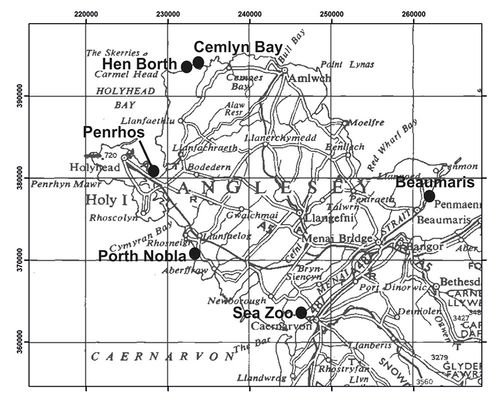OR/14/052 Introduction
| Boon, D, Kirkham, M, and Scheib, A. 2014. Physical properties of till deposits from Anglesey, north west Wales. British Geological Survey Internal Report, OR/14/052. |
Deposits of glacial lodgement till are found across much of Anglesey in North Wales and as a consequence they are of particular importance to onshore and offshore development on the island. The existing geotechnical data originates from the A55 extension through the west of the island, but little data is available for large parts of the island. New data will eventually become available from ground investigations for an extension of the Wylfa Head power station. To address a knowledge gap in the physical properties of till deposits on the island a targeted field-based geotechnical study was undertaken in 2011. The study also aims to complement a current resurvey of the geology of Anglesey. This report describes the methods and results of the study and includes details of a trial of inorganic geochemistry approach to mapping till deposits using XRFS.
The work was funded by NERC National Capability (project NEE2116 S83, Task 1, Engineering Properties of UK Rocks and Soils). The data reported within this report has been entered into the BGS Geotechnical Properties Database (Self et al 2012)[1].
Quaternary geology
During Late Devensian times Anglesey was glaciated from the north-east by ice moving down the Irish Sea (Greenly 1919)[2]. Between major glaciations this ice interacted with ice from Snowdonia and the Conwy Valley and meltwater carved out the Menai Straites (Lewis and Richards, 2005)[3]. These events led to deposition of a complex sequence of glacigenic sediments, the Lleyn Till Member of the St Asaph Glacigenic Formation (McMillan and Merritt 2012[4], McMillan et al 2011[5]; Bowen et al 1999[6]). The surface of Anglesey represents a subglacial landsystem, with widespread erosion and transport of local bedrock and formations of drumlins (Lewis and Richards 2005[3]; Phillips et al 2011[7]).
The recent geological resurvey of the island (see Anglesey iMap) identified two distinct till units, distinguished principally by colour and to a lesser extent composition. Tills are either ‘brown/red’ or ‘grey’ diamictons (Anglesey iMap; Hughes 2011 unpublished MSc Thesis). Sub-glacial processes have introduced hydro-fracture systems, modified bedrock properties at the bedrock sediment interface, locally introduced sand bodies into the till deposits (Phillips and Hughes, in prep) and deposited glaciofluvial sediments that interdigitate with the till.
Field work
Project field work was carried out at 6 coastal sites (Figure 1) where weathered and fresh till is exposed by coastal erosion. The work was undertaken in two phases: Phase 1 (16 to 18 February 2011) involved reconnaissance of potential sites (guided by the Anglesey Mapping Team) with samples taken for geotechnical testing from Cemlyn Bay. Phase 2 (7–11 November 2011) involved taking samples for geotechnical testing from Hen Borth, Penrhos, Porth Nobla, Sea Zoo, Beaumaris and Cemlyn Bay.

References
- ↑ Self, S, Entwisle, D, Northmore, K. 2012. The structure and operation of the BGS National Geotechnical Properties Database Version 2. British Geological Survey Internal Report IR/12/056. British Geological Survey. 61pp.
- ↑ Greenly, E. 1919. The geology of Anglesey. Memoir (District) Geological Survey of Great Britain. HMSO, London. 980 pp.
- ↑ 3.0 3.1 Lewis, C A, Richards, A E. (Eds). 2005. The glaciations of Wales and adjacent areas. Logaston Press. ISBN 1 904396 36 4.
- ↑ McMillan, A A, Merritt, J W. 2012. A new Quaternary and Neogene Lithostratigraphical Framework for Great Britain and the Isle of Man. Proceedings of the Geologists’ Association. 123, 679–691.
- ↑ McMillan, A A, Hamblin, R J O, Merritt, J W. 2011. A lithostratigraphical framework for onshore Quaternary and Neogene (Tertiary) superficial deposits of Great Britain and the Isle of Man. British Geological Survey Research Report RR/10/03.
- ↑ Bowen, D Q (Ed). 1999. A revised correlation of Quaternary deposits in the British Isles. Special Report of the Geological Society of London No. 23, p.174.
- ↑ Phillips, E, Everest, J, Diaz-Doce, D. 2010. Bedrock controls on subglacial landform distribution and geomorphologic processes: Evidence from the Late Devensian Irish Sea Ice Stream. Sedimentary Geology 232, 98–118.